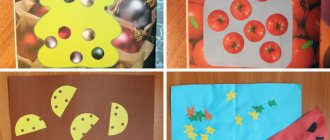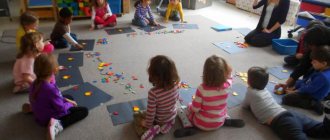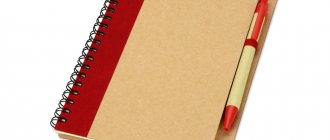Individual work in the preparatory group: a file cabinet with goals
Contents of the article:
When a child moves from the senior group to the preparatory group of kindergarten, this means that the next step on the path of his development will be entering school. It is during this period that children of 6 years old are no longer so interested in games. They begin to develop learning skills. At this stage, it is important to help the preschooler master skills that will help him more easily master new knowledge: concentrate on information, be disciplined and assiduous.
The child must acquire new knowledge and skills in order to quickly join the school community and adequately perceive the school curriculum. Individual work with children in the preparatory group also plays an important role in this.
When planning work with children, the teacher thinks through the interaction with a specific child. As a rule, such individual work of a teacher with a child in a preparatory group is one of the most effective.
At the time of the game or lesson, the teacher’s entire attention is given to one child, and he can notice difficulties in time, guide the student, suggest, and correct.
Card file of individual work in the preparatory group
To assess the effectiveness of a teacher’s work, it is necessary to develop a plan according to which classes, training and educational events will be conducted in a preschool institution. The developed card index of individual work in the preparatory group will provide indispensable assistance to educators as a guide.
It is the card index of the teacher’s individual work with students that contains the necessary data on the sequence of classes, excursions and other workloads that need to be organized for preschoolers in the preparatory group.
Download a card file with goals for individual work in the preparatory group Download in .pdf
Forms of individual work with children in the preparatory group
There is a wide variety of forms of work with preschoolers in the preparatory group. These are games, excursions, conversations, experiments, targeted walks, special activities, reading books, looking at illustrations, etc.
New career opportunities
Try it for free! Curriculum “Teacher Competencies”. For passing - a diploma of professional retraining. Training materials are presented in the format of visual notes with video lectures by experts, accompanied by the necessary templates and examples.
For individual work in the preparatory group on the formation of elementary mathematical concepts, didactic games are used:
- Games with numbers and numbers. To secure the account in forward and reverse order. Pupils, playing didactic games “Which number is missing?”, “Confusion”, “Correct the mistake”, learn to easily operate with numbers and verbally accompany their actions. Games like these help children who are behind in the curriculum learn the material.
- Games - time travel. Help preschoolers consolidate their knowledge of time, days of the week, and the names of all months of the year. These are games such as “Name it quickly!”, “Live Week”, “What time is it?”, “Twelve months”.
- Games for orientation in space. Their task: to teach or strengthen the ability of pupils to navigate in spatial situations, specially created, and to determine their location according to the conditions of the task. These are games - “Tell about your pattern”, “Find a similar one”, “Travelling around the room”, “Artist”, etc. Children through these games learn to find words to indicate the position of objects.
- Games with geometric shapes. Pupils are given the task of recognizing the shape of a triangle, circle, square, rectangle, oval in surrounding objects. Games such as “Make a square”, “Tangram”, “What do they look like”, etc.
- Logical thinking games. Examples: “Mill”, “What is the difference”. They are aimed at training children's thinking when performing actions.
For individual work in a preparatory group
for speech development are used:
- Word games. They develop children's intelligence, attention, coherent speech, and speed of reaction. In such games, students themselves must find signs of similarities and differences between objects, group them by properties, describe them, guess objects from the description, and highlight their inherent characteristics. These are folk games like “Black and White”, “Colors”, etc.
- Board-printed games. Contribute to the systematization of children's knowledge about the world around them, the development of thought processes and operations. Examples of such games: “Paired pictures”, “Loto”, “Dominoes”, folding cubes and cut pictures, “Maze”.
- Games with objects. You can use not only toys, but also real objects. With the help of such games, students learn the signs and properties of objects and learn to classify them. These are games with folk educational toys (matryoshka dolls, barrels, mushrooms, balls), spillikins, mosaics, and natural materials.
- Mnemonic tables, diagrams. This is a system of various techniques that facilitate the process of memorization in children and increase the volume of their memory through the formation of additional associations.
For individual work in the preparatory group on artistic and aesthetic development, the following are used:
- Games with objects. Preschoolers become familiar with the properties of various objects and their characteristics: color, size, shape, quality. Examples of such games: “Create a portrait”, “Forest clearing”, “Entertaining palette”, “Make a bouquet”.
- Printed board games: paired pictures, lotto, dominoes. Solve various development problems. Children love such games; for them it is an exciting activity.
- Verbal didactic games. They teach students to generalize phenomena, classify and assign objects to one category or another.
For individual work in the preparatory group on the development of fine motor skills of children’s hands, teachers use finger games, modeling, paper construction, simple construction, mosaics, and puzzles.
For individual work in the preparatory group in the field of developing logical thinking, stimulating mental processes in children, and developing knowledge about the world around them, printed board games are used. Examples of such games: “Connoisseurs of fairy tales”, “Tale by tale” (associations), “Who lives in the house?”, “Part and whole”, “Name in one word”, lotto “Wild and domestic animals”, “Professions”, “Choose by color and shape.”
Individual work of narrow specialists in preparatory groups
The staff of almost every preschool institution includes a music director, a speech therapist (defectologist), an educational psychologist, and a specialist in physical education and arts activities. Their plans also include individual work with children in the preparatory group
A speech therapist teacher deals with the development of speech in preschool children and, if necessary, creates individual sounds. The physical education teacher evaluates the motor development of children and corrects them in case of lag. The music director forms the general musicality of the students (sensory abilities, sense of rhythm, pitch hearing), develops expressiveness of movements, singing voice.
The systematic work of all specialists together acts as a guarantor of the comprehensive development of a preschooler. And if the child develops, then preparation for school is happening in the best possible way. Another indisputable advantage of individual work in a preparatory group is personal contact between the teacher and the child, during which, in addition to educational ones, educational tasks are also solved.
Plan of individual work with children in the preparatory group for the year
A plan for individual work in a preparatory group with children for a year is a program developed in detail by the teacher for each area of development of a preschooler. If we consider, for example, physical education, the plan will schedule the days and hours of training sessions, jogging, and gymnastic exercises. The necessary standards will be recorded.
Individual work is also carried out during walks in the preparatory group. Outdoor art classes are great when children draw what they see while walking.
www.resobr.ru



